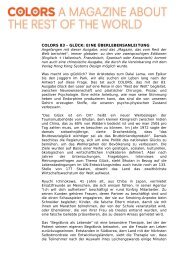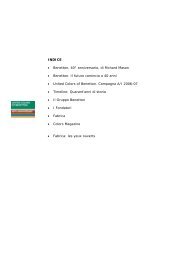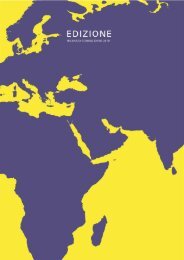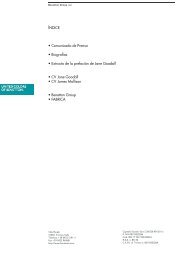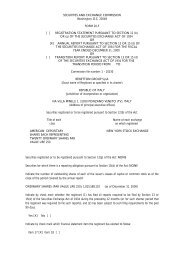The Benetton Group Annual Report 1996
The Benetton Group Annual Report 1996
The Benetton Group Annual Report 1996
Create successful ePaper yourself
Turn your PDF publications into a flip-book with our unique Google optimized e-Paper software.
<strong>The</strong> <strong>Benetton</strong> <strong>Group</strong><br />
<strong>The</strong> <strong>Benetton</strong> <strong>Group</strong> achieved a number of important firsts in <strong>1996</strong>. Consolidated net income reached a<br />
record level, net borrowings were turned into a substantial cash surplus (for the first time in the <strong>Group</strong>'s<br />
history) and, as a consequence, net financial charges were a negligible percentage of consolidated<br />
revenues. <strong>The</strong>se highly significant results derive from continuous innovations that have enhanced the<br />
<strong>Group</strong>’s business systems combined, in recent years, with incisive action to contain both fixed and<br />
variable costs.<br />
Consolidated net income amounted to Lire 246 billion, an improvement of 11.5% with respect to 1995.<br />
Net financial charges of Lire 12.6 billion compare with Lire 46.6 billion in 1995. Self-financing amounted<br />
to Lire 668 billion. Net liquidity of Lire 133 billion follows an improvement of Lire 273 billion during the<br />
year, despite the payment of dividends totaling about Lire 80 billion in <strong>1996</strong>. Operating capital has<br />
fallen by almost Lire 150 billion, from Lire 1,285 billion to Lire 1,137 billion, while consolidated stockholders'<br />
equity of Lire 1,821 billion is 10% higher than at the end of 1995.<br />
Consolidated revenues of Lire 2,871 billion (Lire 2,939 billion in 1995) were influenced by the marked<br />
appreciation of the lira against major currencies (over 8% on average), as well as by the disposal and<br />
consequent deconsolidation of certain businesses no longer considered strategic to the optimization of<br />
the <strong>Group</strong>’s commercial and distribution systems.<br />
Volume rose by almost 4% overall. Substantial growth was achieved within the EU, notably in France,<br />
the UK, Spain, Portugal and Germany, as well as in Eastern Europe and some parts of the Middle East.<br />
Despite the appreciation of the lira, gross margin has remained at more than 40%, while operating<br />
income was 14% of revenues.<br />
<strong>The</strong> ongoing development and renewal of the retail network has contributed to the rise in the volume<br />
of products sold. Work continued in <strong>1996</strong> with, in particular, the opening of new megastores in London<br />
(the world’s largest <strong>Benetton</strong> store), New York, San Francisco, Barcelona, Moscow and Riyadh. <strong>The</strong>se<br />
stores offer complete ranges of clothing and accessories covering all <strong>Benetton</strong> brands, thereby<br />
consolidating public awareness and the <strong>Group</strong>'s image.<br />
On the industrial front, work was completed on the Castrette manufacturing facilities, which are<br />
currently the most advanced of their kind in the world. Investment in innovation has also focused on<br />
applying the latest technology to data processing and applications systems and, above all, to the<br />
continual enhancement of integrated logistics. Here, new automated systems have considerably<br />
improved efficiency and the speed of customer service, while reducing transport expenses by more<br />
than Lire 10 billion. This raises the net savings achieved in <strong>1996</strong> to almost Lire 45 billion, as a result of<br />
projects to reorganize and optimize activities in various sectors of the business, and in certain markets<br />
such as Japan.<br />
<strong>The</strong> <strong>Group</strong> Parent, <strong>Benetton</strong> <strong>Group</strong> SpA, reported net income of around Lire 125 billion, representing<br />
5.9% of revenues. <strong>The</strong>se were 5% higher than in 1995, following growth in the volume of garments sold<br />
despite the appreciation of the lira against export currencies. <strong>The</strong> cost of sales rose by Lire 133 billion,<br />
reflecting the increased volume of production and normal cost inflation.<br />
Rises in selling, general and administrative expenses mainly reflected prudent provisions against business<br />
risks (notably credit collection), and higher agents' commissions under a policy designed to enhance<br />
the effectiveness of distribution arrangements while expanding the sales network.<br />
Income from operations, Lire 259 billion, was 12.2% of revenues. Careful management of the exchange<br />
exposures specifically associated with commercial activities resulted in net gains of Lire 141 billion, partly<br />
due to the strengthening of the lira.<br />
<strong>The</strong> self-financing generated during the year, Lire 387 billion, was particularly significant to the treasury<br />
position.



